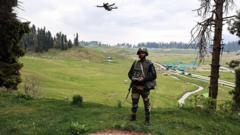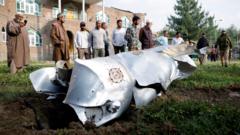In an unsettling parallel to the 1971 war, current tensions between India and Pakistan have been exacerbated by advanced weaponry and a surge of misinformation, creating a climate of panic and confusion.
Tensions Heighten Between India and Pakistan: A Historical Lens

Tensions Heighten Between India and Pakistan: A Historical Lens
The escalation of conflict mirrors past wars but is shaped by modern technology and disinformation.
As the longstanding dispute between India and Pakistan continues to escalate, the current atmosphere resembles the tense backdrop of the 1971 war to many who lived through it. Veteran journalist Hari Kumar recounts his memories of that era while drawing stark comparisons to today's situation, marked by high-tech weaponry and pervasive misinformation.
Kumar reminisces about his childhood experiences during the 1971 conflict, marked by sirens, blackouts, and community gatherings around radios for war updates. Today, however, the landscape has shifted dramatically; conflicts are being waged using drones and missiles targeting civilian areas, rendering borders almost meaningless.
While nationalism remains a powerful driving force in both countries, the means by which it is expressed have evolved drastically. In the 1970s, India was primarily an agrarian nation reliant on local efforts to support its military. Now, as the world's fifth-largest economy, India’s advancements in technology and military capabilities have introduced new risks, with both sides' sophisticated weapons increasing the stakes substantially.
Amidst the confusion, social media and traditional media alike are inundated with disinformation campaigns. This chaotic information environment adds layers of complexity to the already fraught reporting landscape, intensifying public anxiety and uncertainty.
As tensions continue to flare, Kumar affirms the pressing need for clarity in an era where misinformation can escalate fear and misunderstanding, reflecting on three decades of changes and challenges in journalistic reporting amid evolving geopolitical dynamics.
Kumar reminisces about his childhood experiences during the 1971 conflict, marked by sirens, blackouts, and community gatherings around radios for war updates. Today, however, the landscape has shifted dramatically; conflicts are being waged using drones and missiles targeting civilian areas, rendering borders almost meaningless.
While nationalism remains a powerful driving force in both countries, the means by which it is expressed have evolved drastically. In the 1970s, India was primarily an agrarian nation reliant on local efforts to support its military. Now, as the world's fifth-largest economy, India’s advancements in technology and military capabilities have introduced new risks, with both sides' sophisticated weapons increasing the stakes substantially.
Amidst the confusion, social media and traditional media alike are inundated with disinformation campaigns. This chaotic information environment adds layers of complexity to the already fraught reporting landscape, intensifying public anxiety and uncertainty.
As tensions continue to flare, Kumar affirms the pressing need for clarity in an era where misinformation can escalate fear and misunderstanding, reflecting on three decades of changes and challenges in journalistic reporting amid evolving geopolitical dynamics.
















